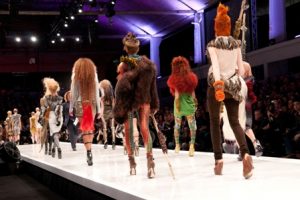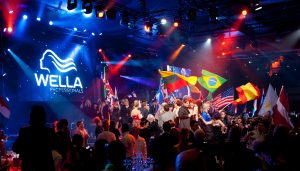After missing last year’s event, lighting designer Richard Knight returned to the Wella International Trend Vision Award 2010 (ITVA), held this year at Paris’s Halle Freyssinet, to make his contribution to a dazzling spectacular.
 Drawing on around 80 GLP impression (impression 90 and impression 120 RZ zoom) LED moving heads, the lighting designer, who specializes in theatrical and corporate events such as this, had a mission-critical role for the fixtures in each location.
Drawing on around 80 GLP impression (impression 90 and impression 120 RZ zoom) LED moving heads, the lighting designer, who specializes in theatrical and corporate events such as this, had a mission-critical role for the fixtures in each location.
Zone 2 became the location for the morning and afternoon catwalk shows and Zone 1 was used for the evening gala dinner and award presentations. These two areas were linked by a central ‘hub’, in the form of a ’live’ TV studio, where interviews took place throughout the day, as well as four ‘trend zone’ exhibition spaces.
Working alongside event production company, Jack Morton Worldwide’s production manager, Glenn Bolton, and producers, Georgia Lavis and Charlotte Duffin, Knight was able to enhance the qualities of the environment while at the same time providing a focus for the entertainment, including the introduction of the four new trends for the coming year.
“The client chose this 20th Century masterpiece of industrial architecture, so we in turn chose to allow the venue to dictate certain decisions. Martin [Sutherland, set designer] created a layout that minimised sightline issues caused by the supporting columns, and made best use of the available space.
“We also made the decision to keep the areas we created within the venue relatively open, allowing me to highlight the venue’s natural ‘Industrial Grunge’ architecture and let the structure of the venue shine through.” This in turn created an interesting juxtaposition between the ‘plain ugliness’ of the venue against some stunningly beautiful hair models, said Knight.
To achieve this, 24 impressions were attached to the pre-existing concrete lintels — edging the Catwalk area in Zone 2 — and a further eight 120 RZ Zooms (with 10°-26° beam) on a FoH truss.
“Using the side-mounted impressions I could illuminate the columns and also cover the ceiling arches with the same fixtures. If I wanted to bling up the TV studio, I just had to point the FoH truss units the other way — back behind the control platform. I could also use the same fixtures to back-light the audience — so in effect they had three jobs.”
In the TV Studio area Knight also provided an additional 12 impressions to deal with a transitional ‘dead zone’ between Zone 2 and Zone 1 — which had to be left clear for emergency vehicle access — and a further 12 GLPs in various locations, including four on a pantograph.
Lighting the morning show presented the main challenge when Wella presented their ideas for the future. “It has a very strong theatrical element with live show director, Kim Gavin’s dancers interpreting each of the four trends, backed with some stunning screen visuals from Knifedge Ltd. Those introductions were then followed by hair models for each trend coming down the catwalk with further interpretations by four major hair salons. From a lighting perspective the trick was to link the screens and choreography in a cohesive piece.” This was followed by the more scientific element of a white light catwalk, enabling everyone to see the hair and models.
 The afternoon was equally visually arresting as each country sent down a hair stylist from the salon which won their national competition, with the corresponding hair models competing against each other.
The afternoon was equally visually arresting as each country sent down a hair stylist from the salon which won their national competition, with the corresponding hair models competing against each other.
In the evening the 2,000 industry professionals arrived back for the gala dinner and competition awards. The stage was adorned with a further four GLP impressions on each of four vertical legs, with another eight for backlighting. The awards presentations were accompanied by performances by The Noisettes, Soul Symphony, aerial artists, roller-bladers and street dance troupe Diversity.
Once again the LED lights more than punched their weight, and the lighting designer was highly impressed. “Now that GLP has the Zoom everything becomes so easy. The impressions were completely rock solid — they have a small footprint and at just 7.5kg that helped get around the venue’s weight loading limitations. There are no dimmers involved and you don’t have to think about them — in effect they serve the purpose of a modern parcan.
“In fact throughout the event we must have used around 1000 lights, including 80 impressions, and I don’t think a single fixture failed all day, which is also a fantastic reflection on my ace lighting team.”
Handling the programming for the morning and afternoon shows was Phil Cole while Seb Williams programmed the evening performance. Responsible for production LX was James Tomlinson and all the lighting and rigging equipment — including the GrandMA control desks — was supplied by RS Rock-Service from Germany, supervised by Peter Oberhofer.

